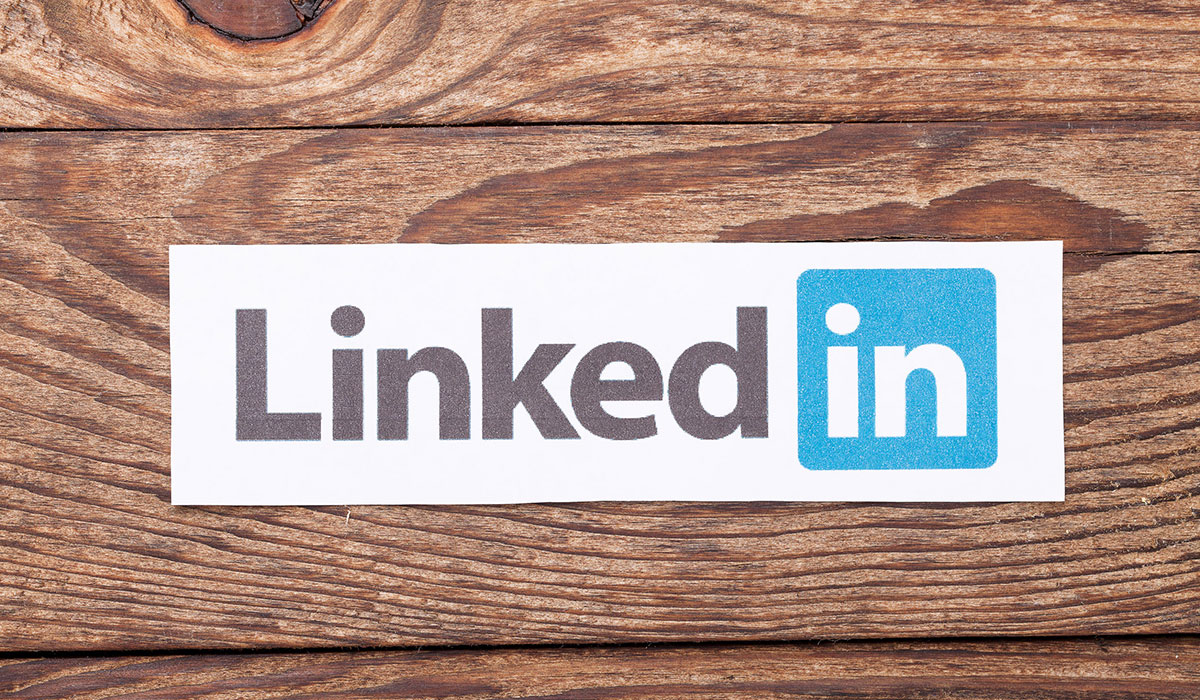What is Personal Branding?
To you, your personal brand is the promise you make to yourself about what you will be remembered for.
To me, your personal brand is the value you deliver when you are at your most genuine and impactful self.
To the world, your personal brand is your reputation reflected in the words spoken about you behind closed doors.
First coined in 1997 by American business titan and writer Tom Peters, personal branding has two parts – the personal brand (noun) is people’s perception of you, and personal branding (verb) is the range of curated behaviours, actions and activities undertaken to shape people’s experience of you and, therefore their perception of you.
Sounds superficial? Yes, it can be. When a personal brand is only skin deep and trying to be something it is not, it feels hollow, fake, and a lack of trust sets in quickly making it a liability. When executed with integrity, a personal brand is rich, strategic, reliable, consistent, deeply authentic, and powerfully impactful– it becomes your strongest asset.
The mechanics of personal branding
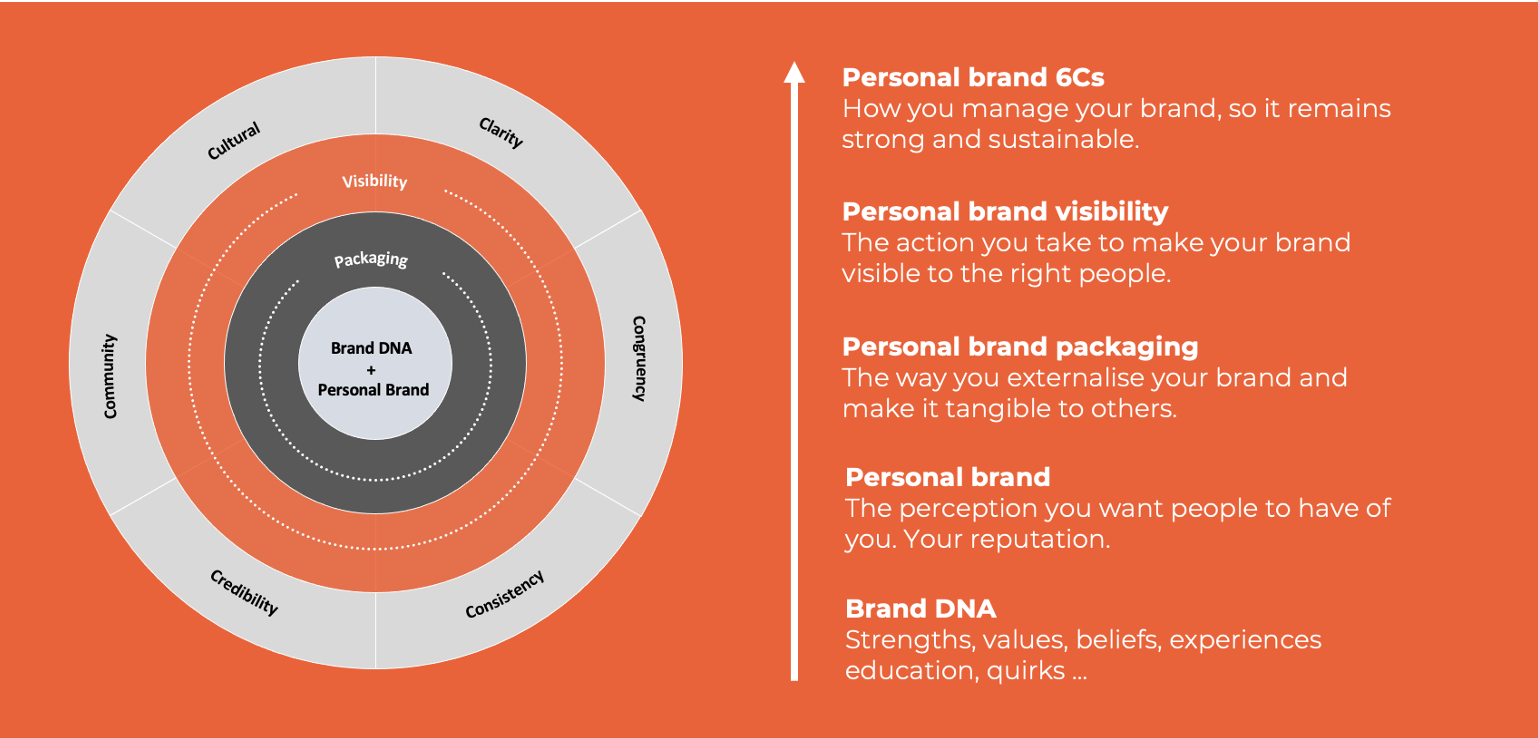
Here’s an interesting fact, we all have an active personal brand whether we want it or not. As humans, we are meaning-making machines, and what we perceive, we convert to meaning and then into belief. Based on a mere 1/10th of a second experience with you (verbal, written, audio, visual), people decide what they believe to be true about you through a process called ‘thin slicing’ (American Psychology Association, Ambady, N., & Rosenthal, R (1993)).At any moment, our behaviours, actions, personal presentation, and attitude will either strengthen or dilute our personal brand.
The good news, you have a choice. Strategically manage people’s perception of you or do nothing and leave your reputation to be shaped by the haphazard words of random individuals. Is there a choice to be made? Certainly not for professionals wanting to expedite the relationships that open doors.
After all, people do business with people they know, like and trust.
Why Personal Branding is Important
Having a personal branding strategy is critical to differentiate yourself quickly and effectively with a unique value proposition that, when strategically leveraged, attracts relevant attention, heightened connection, and career progression.
Sphere of Influence
When people don’t know that you exist or what your expertise is, your sphere of influence and impact is small. But, when you shape people’s perception by consistently illuminating your expertise and its value, your reputation accelerates, your connections grow, and your sphere of influence expands exponentially, opening a whole new world of opportunity for self, team and business.
Differentiation
Going beyond the logical to the emotional benefits of personal branding, the differentiation of your brand is found in the cornerstones of your humanity – core values, strengths, beliefs, motivators, and meaningful moments. A powerful and sustainable personal brand amplifies you at your most genuine and impactful self. Keeping it real makes it easy to show up consistently, strengthening personal brand trust and credibility.
Business Goodwill
When a business culture has values that align with its people, magic happens because values sit at the heart of both personal and business brands. When a professional has a powerful personal brand and generates positive visibility and credibility, the business also basks in the glow created because the positive perception and goodwill will extend to the business brand. Not surprisingly, only 33% of buyers trust messages from a company while almost 90% of customers trust recommendations from someone they know (Nielson). That’s a significant differentiator for the professional who is proactively curating those relationships through their personal branding.
Self-Reflection
Personal branding is just that, personal. No scraping the surface malarky here. We’re talking about an honest, deep-dive personal branding process that unearths you at your best.
If you want all the benefits of having a powerful personal brand, you need to do the exploration, identification and strategy formation outlined below. Additionally, experienced personal branding experts will tell you that you must commit to 15 minutes daily to execute branding activities that consistently create momentum and visibility for your brand.
Personal Brand Strategy
How to Identify Your Personal Brand & Point of Difference
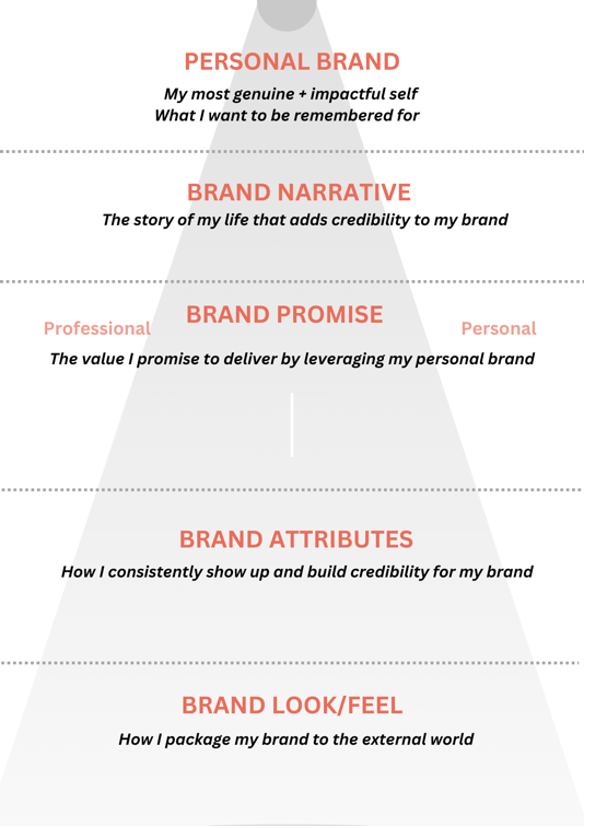
Brand DNA
Start with a large blank piece of paper and title the page ‘The Best of Me’. Next, capture your answers to the following Brand DNA exploration questions.
- What do you do better than others that also gives you deep enjoyment and energy?
- Think of your favourite memories; what was consistently happening in those moments that made it so fulfilling? Download my Core Values: Career Compass Workbook
- Explore situations when you are achieving, look at your behaviours and ask, ‘What does this say about me?’
- What significant moments shaped you, and what lessons or insights did you adopt?
- What formal education, qualifications or job training do you enjoy leveraging daily?
- What quirks or points of difference do you enjoy in your personality or style?
Step back, reflect on the words on the page and then answer:
- Personal Brand:What are you doing when you are being your best self and adding value in a reliable, effortless and deeply genuine way?
- Example: My Personal Brand: Motivational force for greatness.
- Professional Brand Promise (Point of difference): What are you doing when you leverage your personal brand to add value to your professional life? Example: My Professional Brand Promise: I transform passionate professionals into confident, influential changemakers.
- Brand Attributes: Identify 3-5 ways you will consistently live your brand to shape perception through every experience people have with you. Example: My Brand Attributes: Challenging, motivational, practical and supportive.
- Brand Narrative: Why is your personal brand so important, and how did it come about (your story). Example: My Narrative: I believe we are all capable of greatness. As a child with a lisp, I struggled with self-worth, which I overcame by embracing my strengths and differences as a drama student and then a marketing graduate. I went on to combine marketing and coaching to help others unleash their greatness.
- Brand Look/Feel: How will you externalise your brand through your style and packaging, i.e. accessories, attitude, clothes, hairstyle, shoes, and tone of voice? Example: My Brand Look/Feel: warm, bold, relaxed yet professional, structured and well put together with an eye for detail.
Assessing Your Current Personal Brand
Now that you have mapped out your personal brand, it’s time to assess its strengths and weaknesses with a Brand Audit so you can make small revisions to avoid diluting your brand.
Personal Brand Goals
Start the assessment by creating a focus for the next 12 months with a list of S.M.A.R.T. goals identifying what you want to achieve by taking control of your reputation. Think about wins for self, team and business. Knowing your goals is a great motivator to prioritise those critical 15 minutes on busy days.
Understanding Your Target Audience
Use your goals to identify the people you want to be visible to and those who could benefit from your expertise; think organisation, industry, and region. Please understand their pain points and needs and identify how to leverage your personal value proposition to add value by meeting their needs or interests. People love people who add value.
Personal Brand Audit
Assess your professional image by gathering data from your network as an anonymous online questionnaire. You can ask questions to learn what they think is your expertise, strengths, core values, personal presentation and weaknesses.
Packaging Audit
How strong is the representation of your brand in a tangible/visual way?
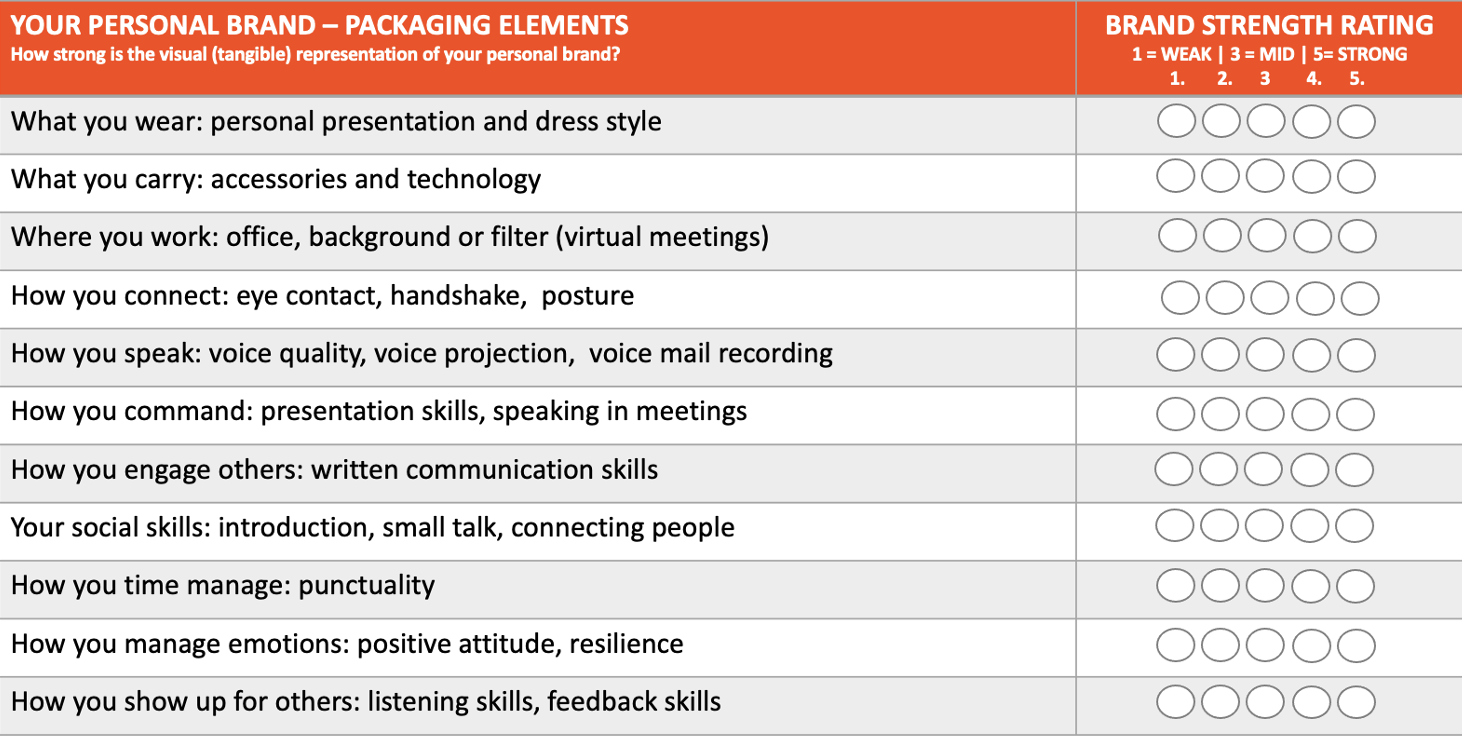
Compare these data points to the personal brand you want and ask yourself, what am I doing well that is strengthening my brand? What am I not doing well that is diluting my brand? What are my blind spots where I need time to process new insights? Move your answers to your immediate action list or longer-term Brand Development Plan.
This audit often results in changing social media images, comments getting deleted, social profiles refreshed with brand-aligned messaging, personal stylists guiding a refresh of your personal presentation, and sometimes a professional photo shoot capturing new profile and content images. At this juncture, I will also activate the BE Expert Collective for my clients to provide media training, presentation skills or blog-writing mentorship.
Company Values Alignment Audit
It is also smart to map your business’s strategic goals and values to your personal values, brand promise, brand attributes and branding goals to identify synergies and gaps. There is serious power in walking the talk and being seen as a champion of the business brand. To maximise these insights, dial up the synergies and storytelling of the alignments, and challenge yourself to find authentic ways to bridge the gaps.
Recent Research conducted by Forrester titled The Algorithm of Authenticityconfirms that ‘consumers are desperate for authenticity’ – they are want what the company says it does and what it actually does to match. One of the most powerful ways for a company to show that match to its consumers is through its people authentically walking the talk every day. To do this company brand and employee brand’s need to have a degree of alignment.
Following is a simple exercise to get you thinking about the strength of your company alignment.
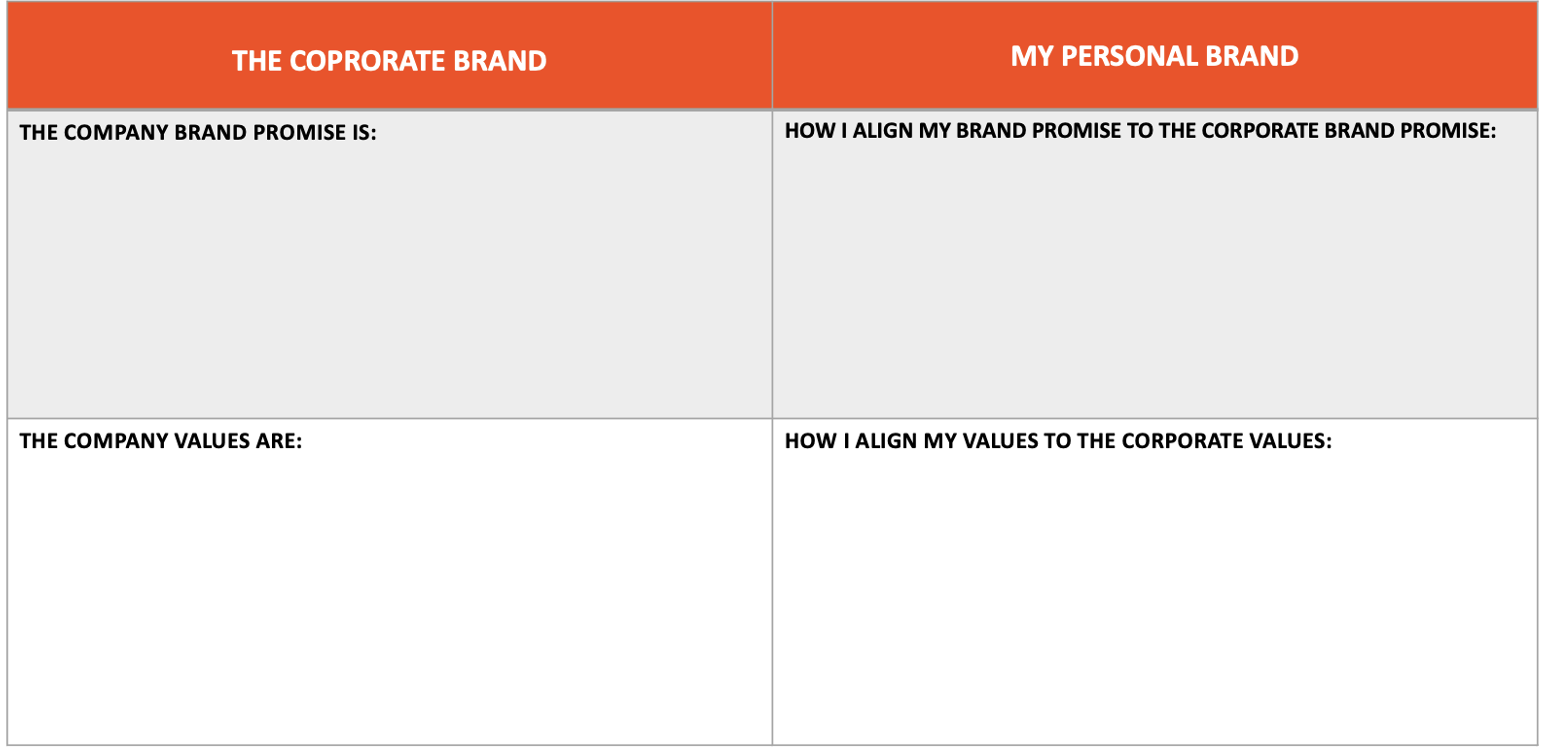
Making Your Personal Brand Visible
There are many ways to make your personal brand visible and expand your sphere of influence and opportunities beyond just undertaking professional networking. I have my clients explore offline and online possibilities, with the secret being to focus on the visibility activities that leverage your strengths so it feels more enjoyable and comes with greater ease.
If you’re not people-centric and don’t thrive in big groups, big networking events are not for you; perhaps one-to-one breakfast meetings or virtual coffees are a better option to expand your network and champions.
Here are some visibility suggestions to spark your thinking:
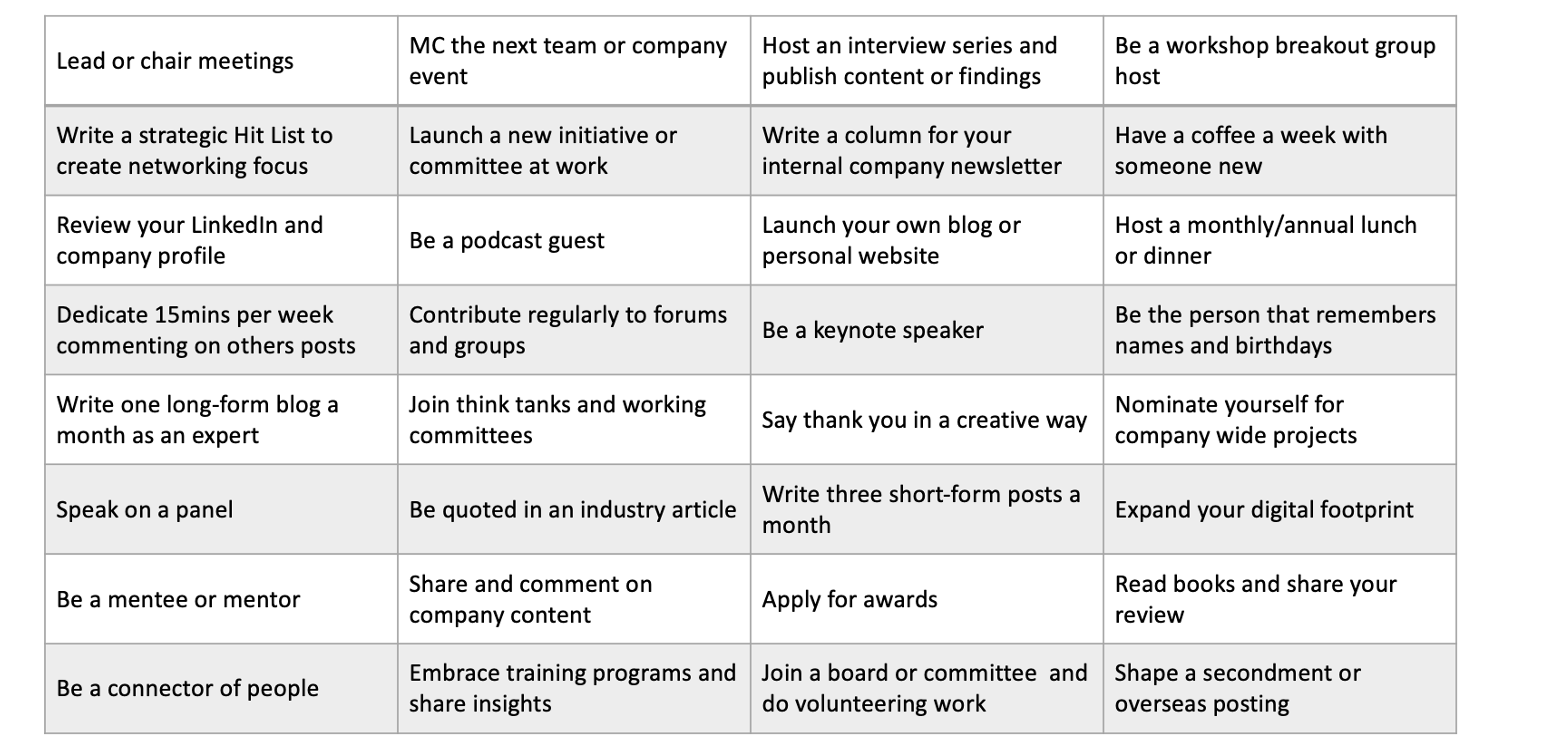
Visibility Audit
A quick visibility audit will tell you where to focus your attention first. Here you are doing an online search to access images, comments, and content that link to your social media channels, online industry groups and internal business platforms.
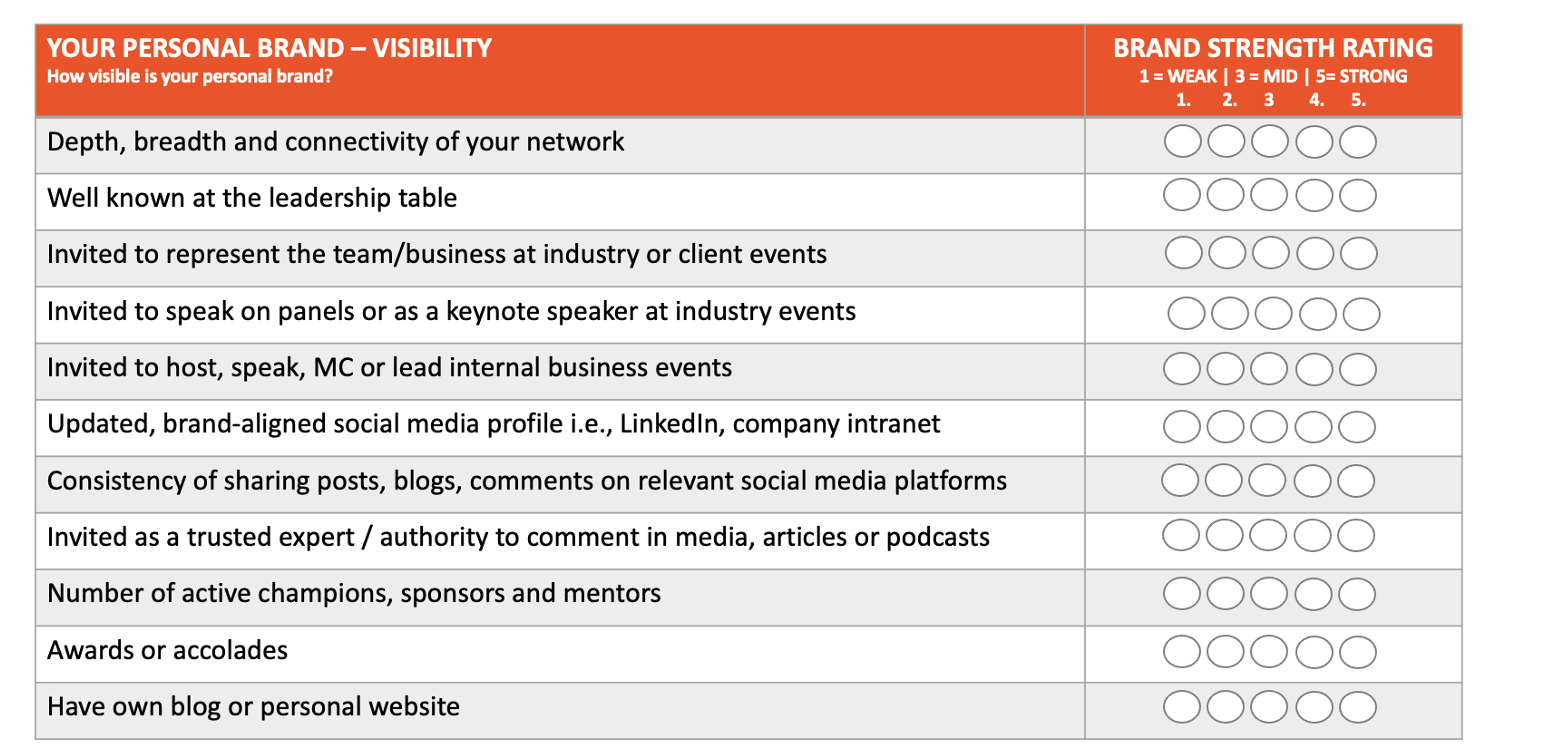
Enhancing Your Brand Offline
Offline branding is often undertaken face-to-face or consists of any personal branding activities not occurring online. For the non-tech savvy or general people-lovers, this is gold. It is wise to schedule a combination of offline and online branding activities because there’s just something different about meeting someone in the flesh that often sparks a deeper conversation and connection.
Here are a few high-ROI offline branding activities I highly recommend:
Weekly Coffee Conversation
Pick someone from your Hit List or a peer, leader, potential mentor or champion, industry titan, gatekeeper, influencer, podcaster, writer or skilled specialist you’d love to learn from. Meet, explore, connect and follow up with a creative thank you that shows you listened, and that highlights your personal brand—one coffee per week, 52 coffees per year and guaranteed countless insights, introductions, and opportunities.
Attend Industry Events and Conferences
Although I’m a ‘people person’ and an extrovert, I don’t thrive attending industry events and conferences because I’m more comfortable with a deeper conversation than a social chit-chat. However, I still go because they are valuable to enhance your exposure and credibility, they offer great opportunities to seek out connections with people or businesses on your Hit List, and you often walk away with cutting-edge insights that can turn into content to be shared internally or as a thought leadership piece. Besides, you never know who you might strike up a conversation with.
Let’s be real; they are a mecca for networking with industry leaders, strategic partners, and potential future employers. Remember to elevate your role from participant to expert panellist, workshop facilitator, breakout group leader or keynote speaker – positions that can accelerate your brand overnight.
Join Committees, Boards or Charities
I get it; seeing a unicorn feels like it has a higher probability than finding spare time to join a committee, board or charity group. However, this offline branding activity is known for its ability to manifest magic. You elevate your brand as someone who is credible and cares, you get to showcase your personal brand value, you expand your network with senior leaders and business owners from different industries, and you get to learn new skills and insights that you can use to immediately add extra impact. This activity can also pave the way for a portfolio career in the future.
Building Your Brand Online
Having a digital footprint is no longer a nicety but an expectation. If you’re an online ghost and don’t exist on Google, do you really exist, and how credible and influential can you be with no online presence? I am sure many credible and influential academics and experts have a limited digital footprint, but if your brand isn’t one of allusive exclusivity, then a digital footprint you must have.
Here’s a motivator, latest research from international career platform CareerBuilder, found that 47% of employers are not likely to interview applicants who do not have an online presence. That’s a huge disadvantage and gamble for career success.
Active Presence
An active online presence makes it easy to shape perception and narrative. You are easily found for business opportunities, speaking roles and media requests as an industry authority. It provides a way to share thought leadership and build worldwide visibility, credibility, and opportunity. You can also effortlessly connect with peers, leaders, strategic partners, and global industry titans while contributing to think tanks and exclusive groups and forums.
A Familiar Start
There are so many ways to be brand aligned and visible online that it can feel overwhelming. Where do I suggest my clients start? Where they are most comfortable being a familiar social media platform.
Excel then Grow
LinkedIn, Instagram, YouTube and business platforms are often the go-to platforms to start the conscious online branding journey. LinkedIn is my choice for professionals. Start small, be consistent, and excel at one or two platforms before growing your exposure to TikTok, Twitter, Snapchat etc.
Following are my top tips as you set out to refine or build a powerful brand online.
Creating a Compelling Social Media Profile
The good news is having already identified your Personal Brand Strategy and completed the Packaging and Visibility Audits; you have the information you need to build a consistent and compelling social media profile.
Consistency
Firstly, use your Personal Brand Strategy to write an introductory About Me profile piece that can act as a template across all your social media profiles to promote your brand. Weave together your Professional Personal Brand Promise, Brand Attributes and Brand Narrative to help shape others’ perceptions of who you are and how you can help them. Be sure to also pepper in language from your Brand DNA to add depth and authenticity to the picture you’re creating.
Where a headline is needed, like on LinkedIn, use your Professional Personal Brand Promise. Then make sure to update all your profiles so they promote your personal brand and shape the reputation you want. Don’t stop there; carry your brand messaging and key brand words through the other platform sections to act as a red thread that brings the reader consistently back to your personal brand.
Images
Next, it’s time to update all images on your social media profiles to professional photos in a professional setting (not your favourite pic from your best friend’s wedding with your ex cropped out because you love how the light falls). A key tip is to do a general Google of your name and see what images appear and if they are brand-aligned. If not, update them even if they are not on a social media platform you are using to promote your professional brand. If you can find the images, so too can your network.
Alarmingly, research from CareerBuilderalso found that 54% of employers do not hire applicants based on their social media profiles. Managing your social profiles is one of the simplest, and most critical, forms of reputation management.
Engagement
Finally, once your social media profiles look good, it’s time to use them to promote visibility and credibility for your personal brand through engagement. Connect and follow individuals and businesses that are beneficial to building your reputation and credibility. Like, comment and share posts from your business, network and people on your Hit List, ensuring your comments highlight your expertise. Write thought leadership blogs or posts, upload video content of yourself, share articles you think are impactful and promote any certifications, awards or client success stories that add credibility to your personal brand.
Two questions to always ask before posting anything to ensure your social media profiles remain on-brand and compelling:
- Does this add value to my audience, or is it a humble brag (which people quietly despise)?
- Does this strengthen my personal brand or dilute it?
Crafting Unique and Original Content for Each Platform
Your Personal Brand defines the content you need to produce to shape the perception of you as an expert. Here’s the thing: if you write about the same content week after week, people will either get bored of the topic, think you are one-dimensional, or both. All of which dilute your brand.
Personal Brand Pillars
The answer is to look at your Personal Brand Strategy and identify four content topics that align with your personal brand that you are passionate about, already masterful at, or have a big appetite for learning about. They become your Brand Content Pillars.
Case Study:
- Personal Brand: Motivational Force for Greatness
- Professional Brand Promise: Transforming passionate professionals into influential changemakers
- Brand Content Pillars: Personal Branding, Confidence Activation, Momentum Generation, Giving Back
- Brand Voice: friendly, conversational, challenging and motivational
Once you have your Brand Pillars mapped out, spend 10 minutes per pillar to brainstorm all possible sub-topics. It will be years before you run out of topics, especially if you get creative and start cross-pollinating pillar topics for a unique and intriguing thought leadership voice.
Medium Selection
When choosing how to present your content, there are two things to consider; firstly, what is the best medium for this social media platform i.e. video, short/long-form blogs, story reels? Secondly, what options best leverage my strengths? For example, if you are analytical but not a writer, using Canva to build an infographic would be quicker, more enjoyable and potentially more compelling than producing a 2000-word blog. Likewise, a video would be best for someone gifted at communication, whereas a story reel of slides might suit someone talented in strategy storytelling to take others on the journey.
Familiar Voice
No matter the medium you choose, ensure your Brand Voice remains consistent, and your language is brand-aligned to enhance familiarity and trust. Don’t toggle between informal to formal with an Oxford Dictionary vibe. Also, be mindful of your audience and tailor your delivery to make them engaged. Don’t use acronyms, terms or language that makes them feel dumb and disconnected from your message.
Consistency is the secret to success in delivering your unique and tailored content regardless of the platform or medium.
Developing an Effective & Consistent Content Strategy
Simplicity spells success when you are a busy professional starting on your content journey—the cadence, medium and days to post need to work for you. As the saying goes, “The best strategy is the one you can stick to’. Again, consistency is the name of the game because it builds trust and momentum.
Simple Monthly Strategy
When you are new to content creation, I would suggest the following monthly strategy be used and replicated (where appropriate) across your chosen social media platforms:
- Week 1:One long-form post per month (2500 words – written or video content) where you dive into the detail of a Content Pillar topic to showcase your authority. Make sure to add interesting subtitles and relevant, compelling pictures. Post using relevant hashtags and tagging of people.
- Week 2/3/4: Short form post/video/quote and comment related to a sub-heading in your original post with relevant hashtags.
- Spend 15 minutes a weekliking, sharing and commenting on your network’s posts and relevant groups and forums you are a part of.
- Spend 15 minutes a week expanding your connections with relevant people and organisations.
Experiment
As you get more confident with your posting, experiment with different mediums – video, Q&A, short-form posts, long-form posts, images, quotes, infographics, interviews, and article sharing with your opinion. Also, think about increasing your posting cadence.
Video Is King
Video is king for content engagement and scalability, with an impressive 50% increase in video views and a 437% increase in LinkedIn Live shows. It’s hard to argue with those numbers! Before you pick up your phone to record, make sure your Brand Look is on point and the background doesn’t dilute your brand – the details matter, so basic is best!
Establishing a Professional Website or Blog
If you are already crushing your content creation and have multiple successful social media platforms, you can level up by creating your own professional website or blog.
Online Personal Brand Hub
These options provide executives with an online hub where all their social media profiles and engagements flow and where they have free reign to curate their personal brand and opportunities uniquely. Often professionals share content from across their life that tell the wider brand story. I want to note that everything shared is still brand aligned but may draw from their sporting pursuits, community work, family life, board positions, and ongoing education.
Here, professionals can actively position themselves in a niche for paid speaking opportunities, column writing, podcast interviews and positions as resident media experts for print, radio and television.
Website Development
Before speeding down this route, I highly recommend hiring a professional to design a customised site using WordPress and incorporate photography and video content to create a powerful online presence for your personal brand. Web designers will also build your site using current Search Engine Optimisation techniques to elevate your ranking for Google searches.
Think it might be time to do things differently?
With our professional and personal lives so busy, isn’t it time to employ this tried and tested way to maximise your effort and impact? A personal branding strategist can help you identify, clarify, execute and refine your strategy to shape perception and accelerate the opportunities and results you’re seeking.
If you are ready to maximise your impact, contact Janine Manning at BE Activation Agency and explore what is possible for you, your team and the business.
Want to know more? Visit us at www.beinfluential.com.au




